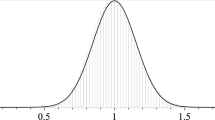Abstract
The electronic Schrödinger equation describes the motion of electrons under Coulomb interaction forces in the field of clamped nuclei and forms the basis of quantum chemistry. The present article continues the author’s recent work (Numer. Math. 98, 731–759, 2004) on the regularity of its solutions, the electronic wavefunctions. It was shown in the mentioned article that these wavefunctions possess square integrable high-order mixed weak derivatives as they are needed to justify and underpin sparse grid and hyperbolic cross space approximation techniques theoretically. How fast the norms of these derivatives can increase with the number of electrons is studied in the present article. Provided that all quantities are properly related to a characteristic lengthscale of the considered atomar or molecular system, the norms of the derivatives remain bounded independent of the number of electrons and the number, the positions, and the charges of the nuclei.
Similar content being viewed by others
References
Agmon S. (1981) Lectures on the Exponential Decay of Solutions of Second-Order Elliptic Operators. Princeton University Press, Princeton
Bungartz H.J., Griebel M.: Sparse grids. In: Acta Numerica 2004, pp. 1–123. Cambridge University Press, Cambridge (2004)
Flad H.J., Hackbusch W., Kolb D., Schneider R. (2002) Wavelet approximation of correlated wave functions. I. Basics. J. Chem. Phys. 116: 9461–9657
Flad H.J., Hackbusch W., Luo H., Kolb D. (2005) Diagrammatic multiresolution analysis for electron correlations. Phys. Rev. B 71: 125115
Flad H.J., Hackbusch W., Schneider R. (2006) Best N-term approximation in electronic structure calculations. I. One-electron reduced density matrix. M2AN 40: 49–61
Flad H.J., Hackbusch W., Schneider R.: Best N-term approximation in electronic structure calculations. II. Jastrow factors. Max-Planck-Institut für Mathematik in den Naturwissenschaften, Preprint 80/2005
Gårding L. (1983) On the essential spectrum of Schrödinger operators. J. Funct. Anal. 52, 1–10
Garcke J., Griebel M. (2000) On the computation of the eigenproblems of hydrogen and helium in strong magnetic and electric fields with the sparse grid combination technique. J. Comput. Phys. 165, 694–716
Griebel M., Hamaekers J.: Sparse grids for the Schrödinger equation. Universität Bonn, INS Preprint No. 0504/2005
Hackbusch W. (2000) The efficient computation of certain determinants arising in the treatment of Schrödinger’s equation. Computing 67, 35–56
Helgaker T., Jørgensen P., Olsen J. (2001) Molecular Electronic Structure Theory. Wiley, New York
Kohn W. (1999) Nobel lecture: Electronic structure of matter-wave functions and density functionals. Rev. Mod. Phys. 71: 1253–1266
Le Bris C. (eds) (2003) Handbook of Numerical Analysis, Vol. X: Computational Chemistry. North Holland, Amsterdam
Le Bris C.: Computational chemistry from the perspective of numerical analysis. In: Acta Numerica 2005, pp. 363–444. Cambridge University Press, Cambridge (2005)
Le Bris C., Lions P.L. (2005) From atoms to crystals: a mathematical journey. Bull. Am. Math. Soc., New Ser. 42, 291–363
Luo H., Kolb D., Flad H.J, Hackbusch W., Koprucki T. (2002) Wavelet approximation of correlated wave functions II. Hyperbolic wavelets and adaptive approximation schemes. J. Chem. Phys. 117: 3625–3638
Messiah A. (2000) Quantum Mechanics. Dover, New York
Persson A. (1960) Bounds for the discrete part of the spectrum of a semi-bounded Schrödinger operator. Math. Scand. 8, 143–153
Podolsky B., Pauling L. (1929) The momentum distribution in hydrogen-like atoms. Phys. Rev. 34, 109–116
Pople J. (1999) Nobel lecture: quantum chemical models. Rev. Mod. Phys. 71: 1267–1274
Stein E.M., Weiss G. (1971) Fourier Analysis on Euclidean Spaces. Princeton University Press, Princeton
Thaller B. (2004) Advanced Visual Quantum Mechanics. Springer, Berlin Heidelberg New York
Weidmann J. (1980) Linear Operators in Hilbert Spaces. Springer, Berlin Heidelberg New York
Yserentant H. (2004) On the regularity of the electronic Schrödinger equation in Hilbert spaces of mixed derivatives. Numer. Math. 98, 731–759
Yserentant H.: On the electronic Schrödinger equation. Lecture Notes, Universität Tübingen 2003; accessible via the author’s homepage
Yserentant H. (2005) Sparse grid spaces for the numerical solution of the electronic Schrödinger equation. Numer. Math. 101, 381–389
Author information
Authors and Affiliations
Corresponding author
Rights and permissions
About this article
Cite this article
Yserentant, H. The hyperbolic cross space approximation of electronic wavefunctions. Numer. Math. 105, 659–690 (2007). https://doi.org/10.1007/s00211-006-0038-x
Received:
Revised:
Published:
Issue Date:
DOI: https://doi.org/10.1007/s00211-006-0038-x



